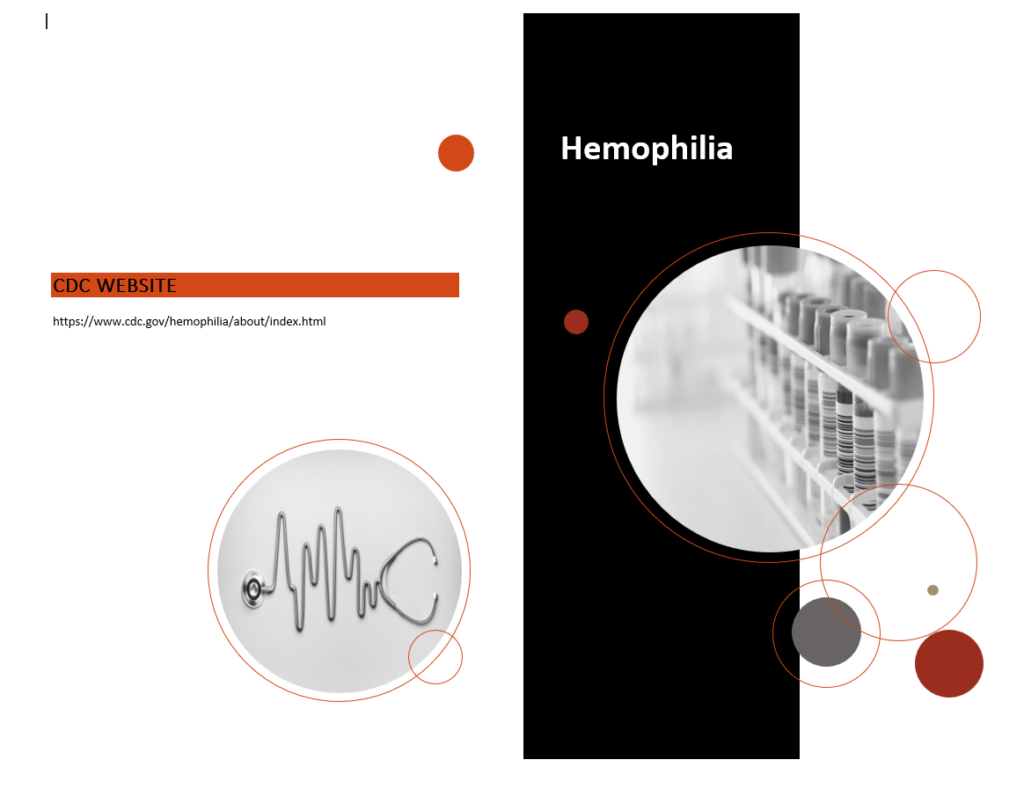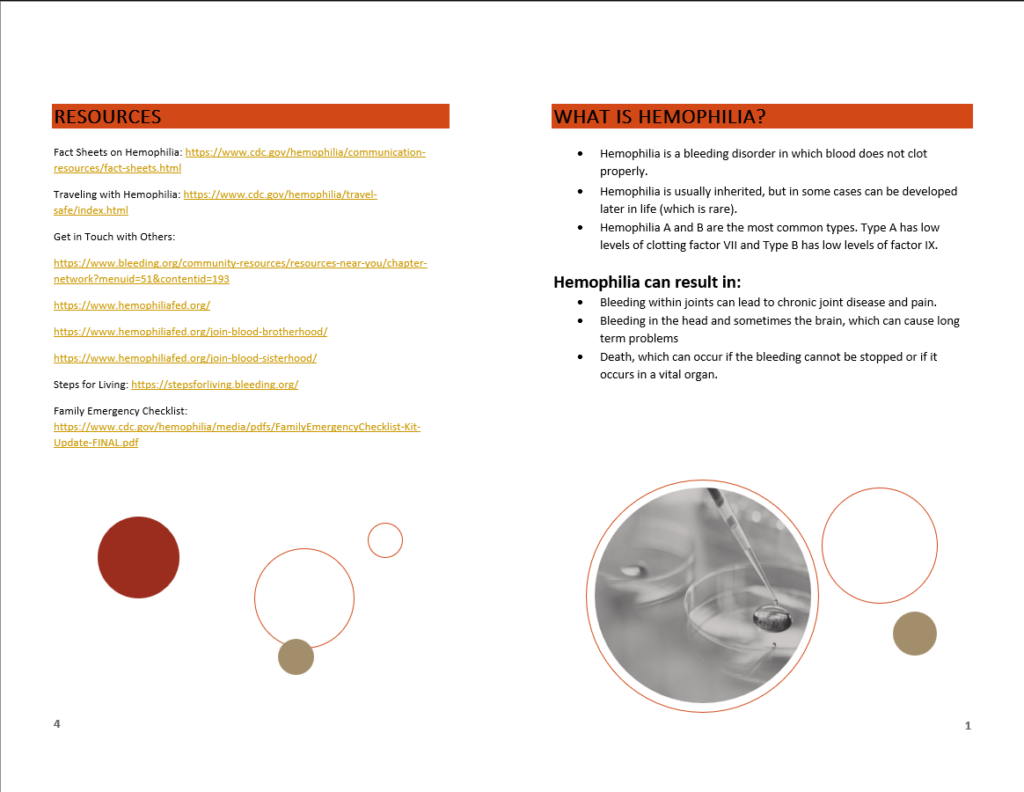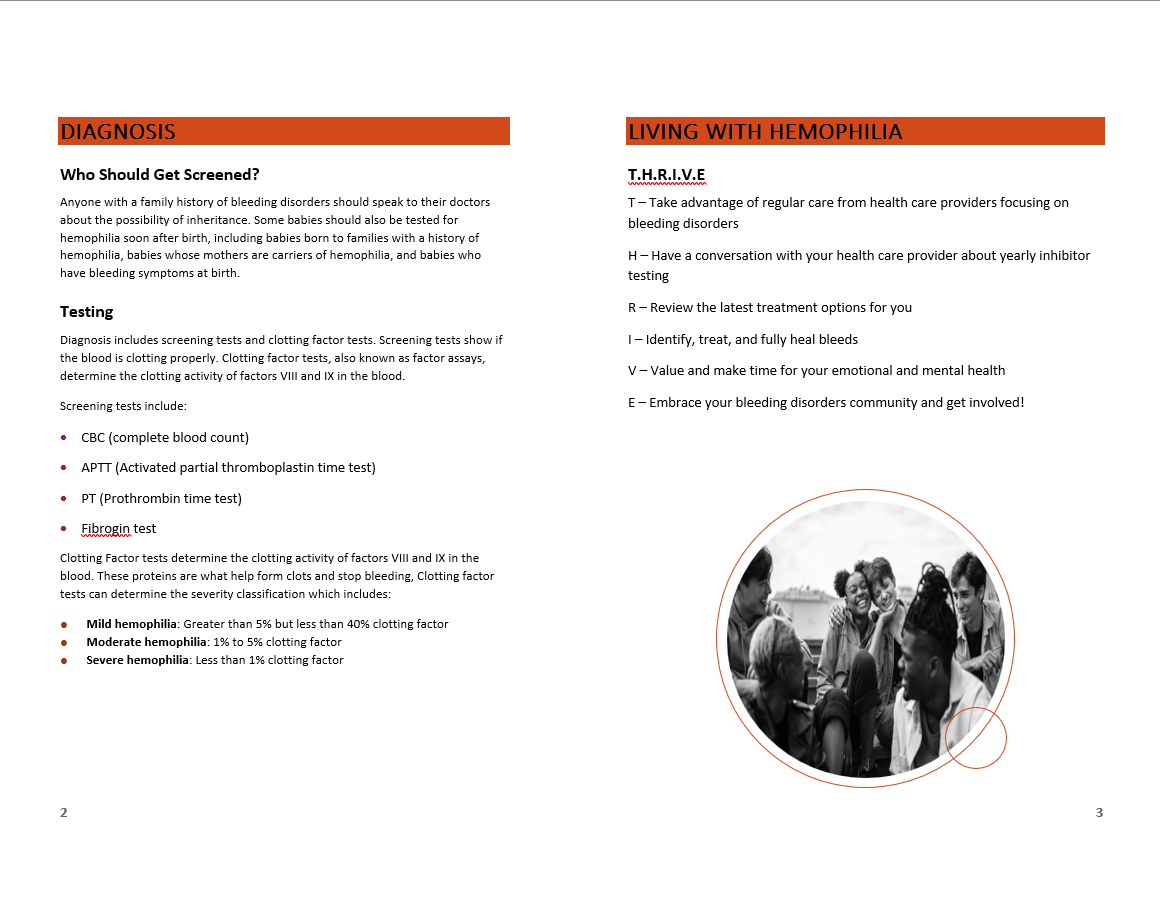



Hemophilia
“Hemophilia is usually an inherited bleeding disorder in which blood does not clot properly” (CDC, 2015). Blood contains proteins called clotting factors that work with platelets to help stop bleeding. Hemophilia occurs when the body doesn’t make enough of these proteins. Low clotting factor levels increase bleeding risk following injuries or surgery, and in some cases can lead to spontaneous bleeding. Hemophilia can result in bleeding within the joints that can lead to chronic joint disease and pain, bleeding in the head and sometimes the brain, and death which can happen if the bleeding can not be stopped or if it occurs in a vital organ. The most common types of hemophilia are inherited. In rare cases, it is also possible for someone to develop it later in life, also known as acquired hemophilia. A majority of acquired hemophilia cases occur in middle-aged or elderly people, or young women who have recently given birth or are in the later stages of pregnancy. This condition often resolves with appropriate treatment.
While there are several types of hemophilia, the most common are Hemophilia A (classic hemophilia) which is caused by a lack or low level of clotting factor VIII, and Hemophilia B caused by a lack or low level of clotting factor IX. There is no way to prevent hemophilia, and if a person has children, it may be recommended that they get genetic testing to see whether they might pass it on to their children. According to the CDC, hemophilia A is about three to four times more common as hemophilia B, and about half of those affected have the severe form. Inherited hemophilia occurs in about 1 of every 5,000 male births. “Based on a study that used data collected on patients receiving care in federally funded hemophilia treatment centers during the period 2012–2018, about 33,000 males in the United States are living with the disorder” (CDC, 2015). Females can have hemophilia, but it is much rarer.
According to the article in the European Journal of Haematology, “The rarity of AHA, low awareness in the wider medical community, and lack of familiarity, may mean that patients are not getting referred to the correct specialist care, or that they remain undiagnosed.” To diagnose hemophilia, doctors perform blood tests to show if the blood is clotting properly. If it does not, they perform clotting factor tests to diagnose the cause of the bleeding disorder. These blood tests show the type of hemophilia and the severity. Severity can be mild (greater than 5% but less than 40% of clotting factor in the blood), moderate (1%-5% of clotting factor in the blood), and severe (less than 1% clotting factor in the blood. Screening tests for hemophilia include a CBC (complete blood count), APTT (activated partial thromboplastin time test), PT (prothrombin time) test, and fibroses test.
Standard treatment options for hemophilia includes replacing the missing blood clotting factor so that the blood can clot properly. One way to achieve this is by injection of commercially prepared clotting factor concentrates. For hemophilia A, another treatment method is injection of a non-factor product that stands in for, or replaces the function of, the missing factor VIII. There are episodic care and prophylactic care. Episodic care is used to stop a patient’s bleeding episodes, while prophylactic care is used to prevent bleeding episodes. “There remain large knowledge gaps when considering how to provide optimal treatment for people with non‐severe haemophilia. Nonetheless, there is a strong rationale that prophylaxis should be considered early in life according to similar strategies as for severe haemophilia for those with a frequent severe bleeding phenotype” (Prophylaxis, 2022).
When living with hemophilia, it is important for patients to take an active role in managing their everyday care. Knowing about hemophilia, understanding the treatment options, and making the best possible choices are important.
References
Centers for Disease Control and Prevention. (2024, May 15). Treatment of hemophilia. Centers for Disease Control and Prevention. https://www.cdc.gov/hemophilia/treatment/index.html#:~:text=Treatment%20overview,commercially%20prepared%20clotting%20factor%20concentrates
Dolan G;Benson G;Bowyer A;Eichler H;Hermans C;Jiménez-Yuste V;Ljung R;Pollard D;Santagostino E;Šalek SZ; (2021, March 18). Principles of care for acquired hemophilia. European journal of haematology. https://pubmed.ncbi.nlm.nih.gov/33527471/
Iorio, A., Königs, C., Reding, M. T., Rotellini, D., Skinner, M. W., Mancuso, M. E., & Berntorp, E. (2023, January). Prophylaxis use of clotting factor replacement products in people with non-severe haemophilia: A review of the literature. Haemophilia : the official journal of the World Federation of Hemophilia. https://www.ncbi.nlm.nih.gov/pmc/articles/PMC10091955/

